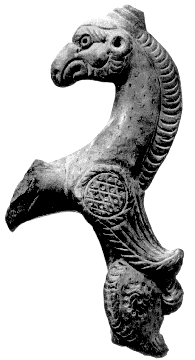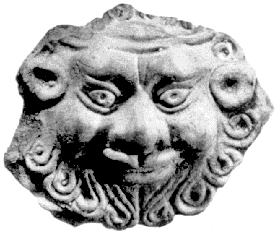|
Warring States to Han Dynasty:
5th-4th c. BC: King Mu is first of Chinese known to travel on Silk Road.
330 BC: Alexander the Great of Macedon conquers Iranian Empire.
325 BC: Palmyra
and Parthia reconquer Persia.
206 BC: Qin Dynasty collapses; Han Dynasty takes over under the rule of Emperor
Liu Pang.
mid 2nd c. BC: Tokhari people migrated from Bulunghir-gol to Khotan.
138-125 BC: Zhang Quian’s journey on Silk Road. Wu Ti sends expeditions
to scout on distant civilizations and improved war horses.
115 BC: Wu Ti forces the Huns to retreat to the north of the Taklamakan Desert.
6 BC-AD 5: Han Dynasty loses control of Tarim Basin to Huns.
1st c. AD: Kushan people (descendents of the Yüeh-chih) move to Tarim,
introducing Gandharan culture to region.
AD 68: Han Emperor Ming Ti sends Cai Yin to the west; Yin returns with 2
Buddhist monks.
AD 73: Chinese general Pan Ch’ao (under Ming Ti) reconquers the Tarim
Basin.
Fig.1: Terra cotta griffin handle from Khotan (Hedin collection,
Montell 1935, pl.12).
.
AD 144-173: Kanishka, a powerful patron of Mahâyâna Buddhism,
is King of the
Kushana dynasty in India (their capital at Taxila).
AD 166: Han Emperor Huan formally introduces Buddhism to China in palace
ceremonies.
After AD 220:
Chinese control over Tarim Basin weakens as Hun invasions and local revolts
widen; silk trade increasingly uses sea route but, 2 sites (Lou-lan and another
near Niya River) provide evidence that the towns along the land route continued
to trade and be influenced by East and West.
. 3 Kingdoms-T’ang Dynasties:
AD 221-265: Period of the “Three Kingdoms;” China gets divided
into rival dynasties.
4th-5th c:  Greatest flow of Buddhism to China, during Northern Wei Dynasty
(AD 386-535). Greatest flow of Buddhism to China, during Northern Wei Dynasty
(AD 386-535).
AD 397: Chinese chronicle Taï-thsing-i-tung-tshi reports Khotan flourishing
as a trade center.
AD 399-early 5th c: Chinese monk Fâ Hsien describes Khotan lifeways,
en route to India through Taklamakan desert (see box at right).
AD 432: Nestorians outlawed in Europe by Roman Church; move to Persia and
Tarim Basin. Fig.2: Terra cotta lion head with diadem (Hedin collection, Montell
1935, pl.12).
5th-6th c: Silk Road traffic increases along with Buddhist influence, with
2 million Buddhists in China by AD 514. Gandharan Kingdom extinguished by
Hephtalite (White Hun) invasions.
AD 589: Chinese regions reunite (Sui Dynasty).
AD 618 -906: T’ang Dynasty expands westward in a “forward policy”
that spread its power farther into Central Asia than ever before.
Hsüan-tsang travels along the Silk Road and writes Hsi Yu Chi. The Caves
of the Thousand Buddhas are heavily utilized by Buddhist monks, nuns, and
worshippers, with considerable T’ang art work added.
.
Late T’ang-Ming Dynasties:
8th c.: Islam conversion begins in Central Asia.
AD 712: Kuteybeh Ibn Muslim conquers west Turkestan including Khotan; probable
destruction of Buddhist temples at Khotan.
 AD 845: Persecution
of Buddhists by Muslims begins. 4,600 temples reported to be destroyed, with
260,500 monks and nuns defrocked. AD 845: Persecution
of Buddhists by Muslims begins. 4,600 temples reported to be destroyed, with
260,500 monks and nuns defrocked.
Fig.4: Terra cotta fish from Khotan, found by Hedin (Montell 1935
pl.XIV). .
AD 906: Fall of T’ang Dynasty; rise of Five Dynasties (AD 907-960).
9th-10th c.: Silk Road traffic and Khotan both decline as Buddism begins
to wane. Arabs take over Silk Road trade as middlemen. “Sea Silk
Route” to China now gains in profitability.
AD 906-1279: Sung Dynasty.
1206: Mongolian tribes unify and begin to conquer Asia under the rule of
Genghis Khan.
1220: Genghis Khan captures Khotan.
1260-1368: Yüan Dynasty (Mongolian).
Late 13th c.: Kublai Khan shows tolerance for different religions; maintains
trade with west on Silk Road; meets Marco Polo in 1272.
1362: Mongolian Empire begins to decline.
1368: Ming Dynasty controls China, isolationist policy closes land route
to west.
15th c.: Most of Central Asia converted to Islam.
This article appears in Vol.3, No.1 of Athena
Review.
.
|